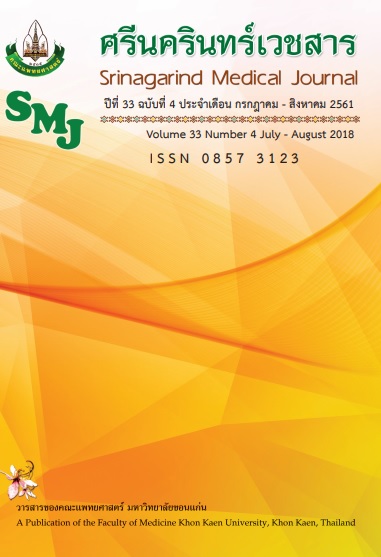Genetically Association of Duffy Blood Groups Antigens in HIV Infection and Severity
Keywords:
HIV; Duffy; Infection; Red cell antigenAbstract
Background and Objective: Human Immuno-Deficiency Virus (HIV) can infect target cells by binding to specific glycoprotein receptors. These receptors have been found expressed not only on target white blood cells, but also red blood cells. The binding of HIV and red blood cell glycoprotein leads to novel infection called trans-infection. This study aimed to investigate the correlation between 3 glycoproteins antigens on HIV infection and its severity.
Method: Expression of glycoproteins antigens on red blood cells was detected using specific monoclonal antibodies by standard tube technique in 60 samples from 2 study groups including healthy control and HIV-infected patients. Then, genotyping of the DARC gene was analyzed using PCR-SSP and PCR-RFLP in 200 HIV-infected patients, in which CD4 level was detected. The association between glycoproteins antigen on HIV infection and severity was statistically tested.
Results: It was demonstrated that only Fyb antigen showed significant association with HIV infection, which was 26.7% and 56.7% of healthy control and HIV-infected patients, respectively. It was also shown that a correlation existed with DARC genotype. FYA/FYB was found at higher frequencies in HIV-infected patients than in healthy control by about 50.5% and 25.4%, respectively. Chi-square testing showed a significant association at p-value <0.0001 and Odd ratio 2.99 (95% CI = 1.817-4.926). However, this antigen lacks any association to the severity of HIV infection.
Conclusion: Red blood cell antigen Fyb enhances HIV infection by 2.99 compared to the normal condition. However, it is not a contributory factor in the severity of HIV infection.
References
2. Douek DC, Roederer M, Koup RA. Emerging concepts in the immunopathogenesis of AIDS. Annu Rev Med 2009; 60: 471-84.
3. Garg H, Mohl J, Joshi A. HIV-1 induced bystander apoptosis. Viruses 2012; 4: 3020-43.
4. Alimonti JB, Ball TB, Fowke KR. Mechanisms of CD4+ T lymphocyte cell death in human immunodeficiency virus infection and AIDS. J Gen Mol Virol 2003; 84: 1649-61.
5. He W, Neil S, Kulkarni H, Wright E, Agan BK, Marconi VC, et al. Duffy antigen receptor for chemokines mediates trans-infection of HIV-1 from red blood cells to target cells and affects HIV-AIDS susceptibility. Cell Host Microbe 2008; 4: 52-62.
6. Walton RT, Rowland-Jones SL. HIV and chemokine binding to red blood cells--DARC matters. Cell Host Microbe Microbe 2008; 4: 3-5.
7. Beck Z, Brown BK, Wieczorek L, Peachman KK, Matyas GR, Polonis VR, et al. Human erythrocytes selectively bind and enrich infectious HIV-1 virions. PloS One 2009; 4: e8297.
8. Trowbridge JM, Gallo RL. Dermatan sulfate: new functions from an old glycosaminoglycan. Glycobiology 2002; 12: 117r-25r.
9. Reich D, Nalls MA, Kao WH, Akylbekova EL, Tandon A, Patterson N, et al. Reduced neutrophil count in people of African descent is due to a regulatory variant in the Duffy antigen receptor for chemokines gene. PLoS Genet 2009; 5: e1000360.
10. Grann VR, Ziv E, Joseph CK, Neugut AI, Wei Y, Jacobson JS, et al. Duffy (Fy), DARC, and neutropenia among women from the United States, Europe and the Caribbean. Br J Haematol 2008; 143: 288-93.
11. Tournamille C, Colin Y, Cartron JP, Le Van Kim C. Disruption of a GATA motif in the Duffy gene promoter abolishes erythroid gene expression in Duffy-negative individuals. Nat Genet 1995; 10: 224-8.
12. King CL, Adams JH, Xianli J, Grimberg BT, McHenry AM, Greenberg LJ, et al. Fy(a)/Fy(b) antigen polymorphism in human erythrocyte Duffy antigen affects susceptibility to Plasmodium vivax malaria. Proc Natl Acad Sci U S A 2011; 108: 20113-8.
13. Kulkarni H, Marconi VC, He W, Landrum ML, Okulicz JF, Delmar J, et al. The Duffy-null state is associated with a survival advantage in leukopenic HIV-infected persons of African ancestry. Blood 2009; 114: 2783-92.
14. Lachgar A, Jaureguiberry G, Le Buenac H, Bizzini B, Zagury JF, Rappaport J, et al. Binding of HIV-1 to RBCs involves the Duffy antigen receptors for chemokines (DARC). Biomed Pharmacother 1998; 52: 436-9.




